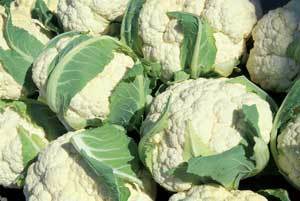

| Botanical Name: | Brassica oleracea ( Botrytis group) |
| Description: | A member of the cabbage family, cauliflower is comprised of bunches of tiny flowerets (heads) on clusters of stalks. Only the flowerets (heads) are eaten. Cauliflower is less tolerant of heat than other members of this genus. |
| Planting Time: | Cauliflower is planted as early as possible in cooler zones. Heads will taste bitter if they mature in warm weather and should be planted in the spring or late summer in warmer climates. |
| Exposure: | full sun |
| Soil: | well-drained, nutrient-rich soil |
| Planting: | Start seeds indoors 6 weeks before transplanting. Sow seeds 1/4 inch deep and 2 inches apart. Set transplants outdoors once temperatures reach 50ºF. |
| Watering: | Avoid getting water directly on the head of a cauliflower. Protect the heads from becoming damaged during heavy rains by temporarily covering them with plastic. |
| Maintenance: | To keep heads white, they need to be protected from the sun (blanched). Wrap leaves around the head when it reaches the size of a baseball and secure them with a rubber band, twine or plastic tape. Make sure the heads are completely dry before wrapping them. Unwrap them after heavy rains to allow them to dry out. |
| Harvesting & Storage: | The size of a mature head depends on the cultivar type and the weather, so harvest the heads when they are solid-before the curds (flowerets) begin to roughen and separate. Store them wrapped in plastic in the refrigerator for up to 1 week. |
| Diseases and Pests: | All members of the cabbage family are subject to a variety of diseases. The best defense is crop rotation and good cultivation practices. |
| Tips: | Remove cauliflower plants after harvesting the heads. Unlike broccoli, no off-shoots will appear when the main head is removed. |
Add your voice! Click below to comment. ThriftyFun is powered by your wisdom!